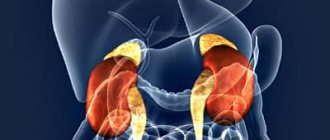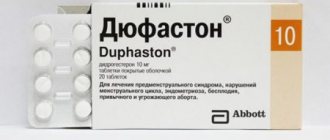Duphaston for endometriosis is prescribed for mild forms of this disease. Mainly in cases where this particular pathology is the cause of infertility. However, prescribing this particular drug is not always the best choice. In some cases, surgical treatment is not possible. And the choice of treatment depends on many factors, starting with what form of endometriosis and symptoms, and ending with the woman’s desire to soon become a mother (if any).
Symptoms and description of the disease
4. Pelvic pain.
5. Pain during sexual intercourse.
6. Infertility.
7. Heavy menstruation.
In addition, endometriosis can be called a companion to uterine fibroids, since both diseases are caused by hormonal reasons - increased levels of estrogen. During menopause, fibroids stop growing, decrease in size, and endometriosis disappears. That is, many women with uterine fibroids will probably also have endometriosis.
The diagnosis of endometriosis (its form, degree of prevalence) can be made by a doctor based on the results of a two-manual gynecological examination, ultrasound examination, as well as histological examination.
Treatment of endometriosis
Today, there are many drugs to treat this disease. The most powerful and effective of them are those that “turn off” the ovaries, that is, artificially introduce the body into a state of menopause. In most cases, the process is reversible, that is, the hormonal levels are completely restored after the end of treatment, menstruation appears again, and the woman can become pregnant. Irreversible menopause can occur if women over 40-45 years of age are introduced into it.
Women who are not prepared for such irreversible consequences and want to have children in the future can ask their doctor how to take duphaston for endometriosis - this drug is milder. Its action is aimed at increasing progesterone levels in the second phase of the menstrual cycle, balancing the levels of estrogen and progesterone.
Duphaston for endometriosis receives mostly good reviews. But this drug can also cause some harm. In the event that the prescription regimen is incorrect and the woman is planning a pregnancy. Before drinking duphaston for endometriosis while simultaneously planning a pregnancy, you need to find out on what day of the cycle ovulation usually occurs. For example, with a 28-day menstrual cycle, this is day 12-14. This is important to do because it is necessary to start taking the drug after ovulation, otherwise implantation of the fertilized egg may not occur. It is necessary to take into account that physiologically, the increase in progesterone, along with all the ensuing consequences, occurs precisely after ovulation. You can find out when ovulation occurred by carefully monitoring subjective sensations (the volume of vaginal discharge may increase, the stomach may hurt a little, libido may increase), by undergoing folliculometry (ultrasound diagnostics) or using special tests at home. The dosage of duphaston for endometriosis is 10 mg 2-3 times a day. On which days of the cycle to take it, you need to find out from your doctor.
Endometriosis is a gynecological disease in which pathological growth of endometrial cells occurs beyond the lining of the uterus or into the abdominal cavity of the small pelvis. There are two forms of pathology: genital and extragenital. The first affects only the organs of the reproductive system, the second can be localized on the intestinal walls, kidneys, bladder, and postoperative adhesions.
Heterotopias (foci) of endometriosis bleed monthly in accordance with the menstrual cycle. Since the blood does not have a way out, inflammation of the pathological and surrounding tissues occurs. This causes acute pain in the lower abdomen, which can radiate to the lower back, rectum, or thigh. The lesions gradually form cysts filled with dark liquid, promoting the formation of adhesions, which can further lead to infertility.
Endometriosis develops against the background of increased levels of estrogen and progesterone deficiency, also possible causes include a hereditary factor, a weakened immune system, infectious, inflammatory diseases of the genitourinary system.
Symptoms of the disease appear especially acute in the extragenital form and have a blurred clinical picture in cases of internal damage to the uterus and ovaries. The main signs of pathology include:
- painful sexual intercourse;
- menstrual irregularities;
- intense pain in the lower abdomen, intensifying during menstruation;
- discomfort when urinating, defecating;
- very heavy periods;
- spotting before and after the end of your period;
- intermenstrual bleeding;
- premenstrual syndrome.
How intensely the symptoms of the disease appear depends on the location of the lesion.
One of the effective ways to treat endometriosis is taking Duphaston. This drug contains dydrogesterone (an analogue of progesterone), which stops the growth of the endometrium and reduces the activity of estrogens, androgens, and corticosteroids. The medicine does not disrupt the ovulation process, does not cause the appearance of male sexual characteristics, and does not affect metabolism, brain function, blood clotting and its lipid composition.
Indications for use of Duphaston:
- lack of progesterone;
- endometriosis;
- premenstrual syndrome;
- irregular menstruation;
- infertility;
- dysfunctional bleeding;
- risk of miscarriage.
Duphaston for endometriosis reduces the contractility of the uterus, muscle tone, and the risk of spontaneous abortion in early pregnancy. The drug also relieves pain, reduces menstrual blood loss, and prevents the degeneration of pathological cells into cancer cells.
Hormone replacement therapy in combination with is indicated for women during menopause, after surgical removal of the uterus to prevent the growth of the endometrium.
Possible side effects:
- migraine, dizziness;
- nausea;
- liver enlargement;
- swelling of the legs;
- allergic reactions: skin itching, erythema, rash.
Side effects occur rarely and disappear after the body gets used to it. In some cases, breakthrough bleeding may develop; the problem is eliminated by increasing the dose of the drug.
Treatment methods for endometriosis
Duphaston is contraindicated in chronic liver diseases and in case of individual intolerance to the active substance. You can take the medicine during pregnancy - it does not have a negative effect on the development of the fetus and does not accumulate in the body.
Dydrogesterone can pass into breast milk, so if urgent therapy is necessary, lactation is stopped.
Treatment of endometriosis with Duphaston is carried out according to a scheme that is selected by the attending physician individually for each patient. The daily dose (10 mg) is divided into 2-3 doses. They start taking pills on the 5th day of the menstrual cycle and end on the 25th day, or take a continuous course.
As hormone replacement therapy, Duphaston for endometriosis is taken in combination with estrogens at a dose of 10 mg/s for 14 days each menstrual cycle. If necessary, the dose can be doubled. This treatment is prescribed with caution to women suffering from kidney disease, migraine, diabetes, epilepsy, and pathologies of the cardiovascular system.
For infertility caused by deficiency, the drug is taken from the 11th to 25th day of the menstrual cycle for 3–6 months. Take 10 mg tablets 2 times a day. Treatment is carried out under the supervision of a doctor. It is necessary to periodically do colpocytology to assess the effectiveness of therapy and dose adjustment.
How should women take Duphaston during pregnancy planning for endometriosis? Treatment is prescribed to girls who have a history of miscarriage or endometrial lesions in the uterus. The daily dosage is 10 mg, divided into 2 doses. People start taking pills from the 11th to the 25th day of the menstrual cycle. Therapy is not stopped even after pregnancy, but from the 20th week the dose is gradually reduced.
https://youtu.be/LGSds34AT4o
Action of the medicine
Before you learn how to take Duphaston when planning a pregnancy, you need to understand exactly how this drug works. This will help you understand why it should be used only on certain days of the menstrual cycle - otherwise, the life-saving remedy can act exactly the opposite - like a contraceptive. The medicine works as follows:
- The drug contains synthetic progesterone, which is known in medical circles as the “pregnancy hormone”: in the female body it is produced on the postovulatory days of the menstrual cycle, responsible for the degree of preparation of the uterus for pregnancy, and subsequently strengthens the fertilized egg; sometimes the reason for the failure of a desired pregnancy is a malfunction in the hormonal system (read more about the effect of hormones during pregnancy), when progesterone is produced in insufficient quantities - this not only makes it difficult to conceive, but also provokes a miscarriage in the future; to make sure that this is your case, you need to undergo certain tests to confirm the lack of progesterone in your body; accordingly, it is recommended to drink Duphaston when planning pregnancy from the 16th to 25th day of the cycle, after ovulation; if the desired conception has occurred, you need to continue taking the medicine until the 20th week, and then gradually reduce the dosage, but do not stop drinking it suddenly - this often leads to an unwanted miscarriage.
Here you need to understand one thing: taking Duphaston when planning a pregnancy will give the desired result only in one case, if the reason for the impossibility of conception is a lack of progesterone in the female body.
If there are other factors that make it difficult to get pregnant, the drug may not be useful. Therefore, you should not self-medicate and prescribe this medicine yourself. Its use is possible only as prescribed by a doctor and after appropriate tests. The specialist should tell and explain in detail how to drink Duphaston when planning a pregnancy and the presence of various gynecological diseases.
If, even after consulting a doctor, there are any doubts about this drug, detailed instructions, which are always included with Duphaston, will help clear them up. It is from it that you can learn that not only infertility is an indication for its use. It is prescribed in the following cases:
- endometriosis (progesterone deficiency); infertility caused by luteal insufficiency; habitual or threatened miscarriage due to progesterone deficiency determined by tests; premenstrual syndrome; dysmenorrhea; irregular menstruation; secondary amenorrhea (in combination with estrogen therapy); dysfunctional uterine bleeding; HRT (hormone replacement therapy): to neutralize the effect of estrogens on the endometrium in women with pathologies caused by menopause (both natural and surgical) with an intact uterus.
Most often, of course, the use of Duphaston is prescribed when planning pregnancy with endometriosis, when tests clearly show a lack of progesterone. With the correct dosage schedule, the results are not long in coming. But this is only if not only the indications for this drug were observed, but also the contraindications.
Duphaston for uterine fibroids
Myoma is a benign formation that forms from the muscle tissue of the uterus. Most often, pathology is detected in women during menopause or after menopause. One of the causes of the disease is considered to be endometriosis due to progesterone deficiency and high estrogen levels. Around heterotopias in the uterus, nodes of smooth muscle cells are formed, which can reach 10 cm in diameter.
In the initial stages, fibroids are asymptomatic; pain occurs only when the pedicle is twisted at the base of the node. Characteristic signs are dysfunctional bleeding and cycle disruption. Large nodes can put pressure on the bladder and enlarge the abdomen.
Hormonal therapy with Duphaston helps eliminate foci of endometriosis, stop tumor growth, and normalize a woman’s hormonal levels. If there are no symptoms of endometrial growth, the drug is not prescribed, as it can accelerate the growth of the node. If pregnancy occurs with fibroids, then the drug must be taken until the 20th week until the placenta begins to synthesize progesterone and the threat of miscarriage disappears.
Therapy should be carried out under the constant supervision of a doctor; if the pathology continues to grow, another treatment method is selected, possibly removing the uterus or enucleating the node.
Contraindications to taking Duphaston for uterine fibroids:
- suspicion of a malignant tumor;
- the size of the node is more than 12 weeks;
- submucosal form of fibroids;
- nodes cause deformation of the uterus;
- torsion and necrosis of the leg.
In these cases, only surgical intervention is indicated.
In our difficult age of chasing education, employment, and career, something important and natural is being missed: conception, long-awaited pregnancy and the birth of a child. The reasons why pregnancy does not occur in a healthy woman are numerous, but the main culprit, as noted by gynecologists and obstetricians, is endometriosis.
Endometriosis is an abnormal process of benign growth of endometrial tissue beyond the boundaries of the uterine mucosa, provoked by hormonal disorders, heredity and other reasons. This pathology is detected when a doctor examines the uterine cavity using an endoscope and is confirmed by the results of ultrasound and histological examination. When a diagnosis is made, it is imperative to carry out the correct treatment, which will help avoid complications of the disease, such as impaired reproductive function. Conception is possible even with such a pathology, if you carefully follow the instructions of specialists.
Indications for hormonal therapy
Duphaston treatment of endometriosis is indicated in the following situations:
- Internal endometriosis (adenomyosis) is the growth of heterotopias in the muscular and serous layer of the uterus. Prescribed mainly in stages I-II of the disease to reduce the volume of menstrual flow and relieve pain,
For adenomyosis, Duphaston is prescribed to reduce pain and the volume of menstrual blood.
- External endometriosis. The use of dydrogesterone is justified for endometrioid ovarian cysts up to 4-6 cm in size. Heterotopias on the pelvic peritoneum and especially in the retrocervical tissue do not respond well to hormonal therapy. Duphaston is also prescribed in preparation for surgery and after surgical treatment,
- Extragenital endometriosis. Dydrogesterone is used in the complex treatment of heterotopias of the bladder and intestines.
Duphaston is rarely prescribed for a significant spread of lesions - large ovarian cysts, deep tissue damage to the pelvic cavity, grade III-IV adenomyosis. When the process is advanced, it may be advisable to use stronger drugs - gonadotropin-releasing hormone agonists. In some cases, surgery followed by hormonal therapy is indicated.
Duphaston is prescribed with caution in case of combined pathology - simultaneous detection of uterine fibroids and endometriosis. Clinical studies show that dydrogesterone, like other gestagens, provokes the growth of myomatous nodes and leads to the progression of the disease. For now, this issue remains controversial, and doctors continue to prescribe progesterone drugs for fibroids with endometriosis - under mandatory ultrasound monitoring of the growth of the node.
If endometriosis is accompanied by uterine fibroids, then Duphaston is prescribed with extreme caution.
It is important to know
Indications for hormonal therapy are determined by the gynecologist after examining the patient. It is necessary to make an accurate diagnosis, understand the stage of development of the process, assess the state of the reproductive system and select the optimal treatment tactics.
Planning pregnancy during the treatment of endometriosis and its favorable course
Endometriosis, or rather its consequences in the form of extensive, constantly growing lesions, prevents the penetration of the egg into the uterine cavity. Infertility occurs depending on the stage of the location of the affected tissues for the following reasons:
- formation of ovarian cysts;
- adhesions and obstruction of the fallopian tubes;
- damage to the uterine cavity.
The coexistence of untreated endometriosis and if the egg managed to implant has been scientifically proven. During the period of bearing a child, the process of tissue proliferation stops, since natural hormonal therapy is carried out.
Attention! Prolonged lactation, which appears, contributes to the stagnation of the pathology and stabilizes the situation for several years. After finishing feeding your baby, it is better to consult a doctor to cure endometriosis.
If endometriosis was detected during pregnancy, then it is necessary to understand how existing disturbances in the functioning of a woman’s reproductive system can cause a risk of miscarriage. Doctors do not recommend pregnancy in the presence of pathology for the following reasons:
- increased chances of ectopic pregnancy;
- early miscarriage;
- disturbances during egg implantation during IVF;
- the consequence of an abortion according to indications may be uncontrolled growth of the endometrium;
- threat of miscarriage in the second trimester of pregnancy;
- threat of uterine rupture in the last trimester with adenominosis (internal endometriosis).
When the embryo reaches 9 weeks of gestation, the placenta begins to develop and the risk of miscarriage decreases sharply. During this period, the impact of pathology on pregnancy ceases to be threatening. Natural hormone therapy begins:
- bleeding ends;
- symptomatic pain characteristic of endometriosis disappears;
- the discharge of mucus and blood from the hindgut stops, if such was the result of pathology.
Pregnancy with this disease is not only possible, but is also a natural therapy, and a huge advantage is that the pathology does not spread to the child located in the placenta.
Despite the possibility of conception and pregnancy, doctors emphasize that endometriosis should be treated before pregnancy.
Treatment options for endometriosis
Planning pregnancy includes mandatory treatment of pathology, especially if the disease has reached stages 3-4. The strategy for the treatment of endometriosis is developed depending on the situation and nature of the disease:
- if the patient already has children and does not intend to plan a pregnancy, in the absence of painful symptoms, the doctor uses expectant management;
- elimination of foci of endometrial growth using laparoscopy;
- hormonal therapy.
The main principle of hormonal treatment for endometriosis is the constant suppression of estrogen.
The ability of duphaston to help in the treatment of endometriosis
The main active substance of the drug is the latest generation hormone dydrogesterone. One tablet contains 10 mg of the active substance of the hormone dydrogesterone. Its structure is very close to natural progesterone, which gives it unique properties:
- does not have a wide range of androgenic effects characteristic of synthetic progestogens created on the basis of the male hormone testosterone;
- has thermogenic activity - the ability of the drug to streamline the cycle, maintaining the ability to get pregnant and save pregnancy in the event of a threat of abortion;
- treats progesterone deficiency, which reduces the threat of recurrent miscarriages;
- reduces the effects of PMS: reduces irritability, nervous excitability;
- evens out dysmenorrhea (cycle irregularity) and does not interfere with menstrual function;
- indicated for the treatment of dysfunctional uterine bleeding;
- does not affect hemostasis, carbohydrate and liver metabolism;
- does not contribute to the occurrence of edema;
- does not suppress ovulation, as it is not a contraceptive;
- does not affect the health of the fetus.
When taken orally, the drug is instantly absorbed from the gastrointestinal tract, reaching therapeutic concentrations after two hours. Within 24 hours, 75% of the drug is excreted in the urine, and after three days the drug is completely eliminated.
The main indication for use is progesterone deficiency caused by the following conditions:
Duphaston can help as an agent of hormone replacement therapy, neutralizing the proliferative effect of estrogens on the endometrium for women with menopause in the intact uterus. A gynecologist will prescribe duphaston for endometriosis, depending on the stage of development of the disease.
According to the instructions, the drug is contraindicated for persons with individual sensitivity to any substances of the drug, adolescents under 18 years of age, and nursing mothers, due to the ability of the hormone to pass into milk. Prescribed with caution to women who have previously experienced symptoms of itching during pregnancy. Duphaston has side effects, but they are much less pronounced than those of similar drugs. Observed:
- headaches, migraines;
- isolated cases of changes in liver function were noted;
- in rare cases, increased breakthrough bleeding, which stops when the dose of the drug is reduced;
- allergic reactions, including skin itching and urticaria, very rarely Quincke's edema occurs;
- increased breast sensitivity;
Any case of side effects noted by the patient that occurs during hormone therapy is immediately reported to the attending physician. By reducing the dosage of the medicine, a complete disappearance of unpleasant symptoms is observed almost immediately. Duphaston is a drug compatible with alcohol intake, because the manufacturer does not impose any special contraindications for alcoholic beverages. However, doctors strictly recommend abstaining from drinking alcohol.
Hormone treatment: how to take duphaston for endometriosis and planning pregnancy
Hormonal therapy is prescribed depending on the lesions of the endometrium, most often these are the first and second stages of endometriosis.
Attention! Hormone therapy does not guarantee a complete cure. Symptoms usually return after stopping the drug.
Thanks to the features of duphaston, i.e. Due to the similarity of the active substance with natural progesterone, the drug is prescribed to patients with the following conditions:
- During the period of pregnancy, the drug maintains pregnancy by maintaining normal levels of progesterone in the mother's body, which significantly reduces the chance of miscarriage. Reduces uterine capacity and muscle tone.
- In case of a threatened miscarriage, the woman immediately takes 40 mg, then 10 mg every 8 hours until the symptoms completely disappear.
- In the treatment of uterine fibroids. Reduced portions of the drug can affect the depletion of uterine formations, but larger doses can cause the growth of benign tumors. Only a qualified gynecologist can prescribe the drug and indicate how long to take the drug.
- against the background of existing fibroids. Bearing a fetus, complicated by myomatous formations, is supported by hormone therapy, which allows the egg to attach to the endometrium and develop into a full-fledged fetus. A dosage of the drug of 10 mg twice a day is justified until the 20th week, at which point the placenta already produces progesterone on its own. If the risk of miscarriage is still possible, the doctor decides to reduce the dosage and continue therapy until the patient’s condition improves.
- In the treatment of infertility, the cause is a symptom of luteal insufficiency. Daily intake of 10 mg of the drug from the 14th to 25th day of the cycle, the course is continuous for six months.
- With the formation of myomatous nodes complicated by endometriosis. Hormone therapy with duphaston helps in eliminating mimomatous tumors, under the strict supervision of the attending physician, who, based on indicators, determines the duration of treatment and the beneficial effect.
- For endometriosis. Dydrogesterone stops the growth of the endometrium, reduces the activity of estrogens, androgens, and corticosteroids. The daily dose (10 mg) is divided into morning and evening doses, the drug must be taken on day 5-1 of the menstrual cycle and completed on day 25, or take a continuous course.
- When planning a pregnancy. The drug normalizes hormonal levels and, without having a contraceptive effect, does not suppress ovulation.
- Correction of conditions associated with the menstrual cycle. The product relieves irritability during PMS, evens out cycle irregularities, and reduces dysfunctional uterine bleeding.
Collapse
The active component of Duphaston is dydrogesterone. The medicine rarely causes side effects and does not accumulate in the body. Duphaston for endometriosis can be used during gestation, which is crucial for patients planning pregnancy.
What is Duphaston
Duphaston is a drug that is considered a substitute for the female sex hormone - progesterone. It directly affects the production of the hormone in the second phase of menstruation. The drug affects the internal mucous membrane of the uterus, preventing the epithelium from growing pathologically.
Duphaston for endometriosis has a mild effect on women's health, so patients of different age groups can be treated; its use according to the instructions for endometriosis practically does not cause side effects.
The medicine is presented in film-coated tablets. Its use does not negatively affect the liver and functionality, as well as metabolic processes.
Duphaston in the treatment of endometriosis does not suppress the onset of ovulation, therefore it is approved for use by women who are planning a pregnancy.
For preventive purposes (to maintain pregnancy), the drug is prescribed to patients in the first months of pregnancy. Its use reduces uterine contractions, which allows a woman to carry the fetus to term.
The drug can be used both for treatment and for prevention purposes. During therapy, patients' pain decreases and prostaglandins are suppressed.
It has also been noted that the tablets reduce the amount of menstrual blood discharge and also prevent the cells from degenerating into malignant neoplasms.
The advisability of taking Duphaston
The drug is recommended for use in mild forms of endometrial damage. Duphaston, being a synthetic analogue of progesterone, suppresses the production of estrogens, an excess of which can cause endometriosis. In addition, the drug stabilizes hormonal levels and normalizes the menstrual cycle, eliminating painful sensations associated with menstruation. It is known that endometriosis does not occur if a woman does not have an imbalance of sex hormones.
The disease suppresses ovulation and ultimately causes infertility in the initial stages. If hormonal disturbances are mild, then after a course of treatment with Duphaston the patient becomes pregnant, which happens quite often. In the later stages of the disease, adhesions occur in the ovaries and fallopian tubes, and the risk of developing irreversible infertility increases significantly.
Women are prescribed to drink Duphaston for endometriosis not only to treat infertility, but also to solve problems with pregnancy. To prevent miscarriage due to progesterone deficiency, it is recommended to begin therapy in the 1st trimester of pregnancy.
Taking Duphaston for endometriosis and endometrial hyperplasia very often gives good results. The drug inhibits the process of pathological division of endometrial cells, stopping its growth, and gradually the foci of affected tissue are replaced by normal tissue. In later stages, longer therapy is necessary, and in cases where it does not make sense, the patient is prescribed surgical treatment.
The positive effect of taking the drug for the treatment of endometriosis lies in its multifaceted effect on altered tissues. Particularly valuable is the quality of Duphaston, which reduces the likelihood of malignant degeneration of affected tissues. In addition, the beneficial effect of the drug has been proven if the patient has heavy discharge, pain and cramps during menstruation. During treatment, women note a decrease in irritability, nervous excitability, and improvement in the condition of the skin.
Reviews from doctors on the use of Duphaston
The opinions of doctors regarding the beneficial or negative effects of using the hormone are completely opposite and are divided into two groups.
The first group of doctors gives positive feedback regarding the effect of duphaston in the treatment of the following conditions:
- the presence of myomatous nodes, which often decrease in size, which makes it possible to avoid surgical intervention;
- pregnancy with uterine fibroids;
- with a combination of nodular formations and endometriosis, the hormone helps to restrain the growth of uterine tissue;
- normalizes the condition of the uterine mucosa, creating favorable conditions for conception and gestation, resulting in the birth of a healthy child.
A negative review of the use of duphaston is described by the second group of doctors regarding the following conditions:
- Incompatibility of the drug in the treatment of endometriosis complicated by a disease such as uterine fibroids, since large doses of the hormone can cause tumor growth;
- The effect of the hormone on the growth of latent tumors.
All of the above proves that the decision in the fight against tumors with the help of hormone therapy can be made solely under the weight of such factors: pregnancy with a threat of miscarriage, the effect of the drug on endometriosis. A qualified doctor has the right to prescribe a hormone, since taking hormones under the influence of other people’s advice is dangerous.
Hormone therapy in gynecology includes the use of the drug Duphaston for endometriosis. This drug is also of particular value for those who have problems conceiving.
Contraindications and side effects
While taking Duphaston, patients rarely notice side effects caused by dydrogesterone. Sometimes there is tension and discomfort in the mammary glands, migraines, dizziness, swelling of the lower extremities, allergies, pain in the liver.
Duphaston is contraindicated in the following cases:
- individual intolerance;
- liver diseases;
- breastfeeding a baby.
Before starting Duphaston therapy, the doctor collects a complete medical history, conducts studies and mammography, in accordance with the accepted screening, to exclude diseases that are incompatible with taking the drug. The patient is informed about all possible changes in the body that may occur while taking the medication and is asked to report anything that worries her.
At the beginning of treatment, breakthrough bleeding is possible. If they continue to occur periodically after several months of therapy, then an endometrial biopsy should be performed to exclude the possibility of malignancy.
Contraindications for treatment with progesterone drugs
Duphaston is not prescribed in the following situations:
- Individual intolerance to dydrogesterone,
- Hormonally active neoplasms of various localizations,
- Vaginal bleeding of unknown etiology,
- Breastfeeding period
During lactation, treatment of endometriosis with Duphaston is contraindicated.
- Liver pathology currently or in history (if the indicators of functional tests are violated),
- Hereditary diseases with impaired enzyme production.
Duphaston is not prescribed to girls under 18 years of age - there is insufficient data on the safety of the drug. Dydrogesterone is used with caution in the presence of risk factors for thromboembolism - previous myocardial infarction, stroke, thrombophlebitis, autoimmune pathology, diabetes mellitus, etc. In the premenopausal period, Duphaston is prescribed after consulting a therapist. After 40 years, diseases of the cardiovascular system are often detected, which can become contraindications to the prescription of hormones.
Duphaston is used for mastopathy – a benign pathology of the mammary glands. Before starting therapy, it is necessary to exclude malignant neoplasms of the organ, especially with a burdened medical history (presence of first-degree relatives with breast cancer).
Mode of application
How to take Duphaston for endometriosis? According to the standard regimen, it is necessary to use the drug for six months. The period can be extended if necessary, but this is decided only by the doctor. The dosage depends on the stage of the disease; in the initial stages, 10-20 mg per day is sufficient. In more severe cases, the amount of the drug can be increased to 30 mg per day, divided into 3 doses. Therapy is carried out from 5 to 25 days of the cycle.
If the patient is prescribed a combination treatment, it will most likely be long-term. In a similar way, you can prevent conception until a woman decides to give birth to a child. The drug will help stabilize hormonal levels. When planning pregnancy, treatment of endometriosis with dydrogesterone occurs according to the generally accepted scheme from the 14th to 25th day of the cycle. This will create a favorable hormonal background for the upcoming conception.
A habitual miscarriage requires twice taking the drug 10 mg vpl
Other packaging
until the 20th week of pregnancy, then the dosage is gradually reduced. In case of threatened miscarriage, take 40 mg of Duphaston once, followed by 10 mg every 8 hours.
The drug is also effective for PMS and cycle disorders. It has a positive effect on the patient’s emotional state and the severity of pain. It is taken from days 11 to 25 of the cycle, twice a day, 10 mg. To stop dysfunctional bleeding, it is recommended to take 10 mg tablets twice a day for 5-7 days.
Therapy should not be stopped immediately after pregnancy. This may cause disruption to the development of the embryo. Treatment of endometriosis with Duphaston during pregnancy should be carried out strictly under medical supervision. In most cases, the drug must be taken until the 20th week of pregnancy. Only then can the maximum effect of treatment be achieved.
Duphaston, taken in the early stages of pregnancy, creates the necessary hormonal background that prevents the rejection of the fertilized egg due to endometriosis. The drug reduces uterine contractility by inhibiting the production of oxytocin, which also ensures the preservation of pregnancy.
Treatment of endometriosis with Duphaston tablets after surgery
In some cases, a woman needs surgical treatment. It is most often required when pathological cysts have already formed on the ovaries or in the abdominal cavity. After the surgical intervention, correction with Duphaston is prescribed.
Depending on the woman’s wishes, any of the correction schemes presented above can be chosen.
In the early stages of pregnancy, hormonal treatment cannot be canceled. This can lead to interruption of embryo development. Only your doctor will tell you how much Duphaston to drink in this case. In most cases, the drug must be taken until mid-pregnancy. Only the effect of treatment will be maximum.
When choosing a traditional correction regimen, you need to take the medicine for six months. If necessary, the period of taking the drug can be extended by the doctor.
If combination therapy is chosen, such treatment can be long-term. Until a woman wants to give birth to a child, she can protect herself using this method.
The effect after surgical treatment should appear immediately. The drug "Duphaston" will only maintain hormonal levels in a normal state and will not allow endometriosis to again affect the woman's genitals. Hormonal therapy in this case is prescribed for a period of six to nine months.
Before taking the drug Duphaston, the instructions, price and duration of treatment should be analyzed in detail. The annotation must be studied in order to know about the composition of the drug, side properties and method of storage.
Each package of medicine contains instructions for the drug "Duphaston". The price of one pack ranges from 500 to 600 rubles. That's how much 20 tablets cost. Depending on the region in which the drug is sold, its cost may vary. Also, different prices are set in different pharmacy chains.
It is worth noting that treatment with Duphaston tablets is very effective. The most positive effect can be achieved when planning pregnancy during hormonal correction.
Reviews from representatives of the fair sex suffering from this disease indicate that pregnancy occurs quite often while taking the drug. And this is even despite the fact that before this the women were given a terrible diagnosis of infertility. During pregnancy, there is no menstrual cycle and, as a result, the endometrium does not grow. Foci of endometriosis undergo reverse development during this period. They become smaller or disappear altogether. After the baby is born, long-term breastfeeding is recommended. This is due to the fact that against the background of the production of prolactin (the hormone of mother's milk), menstruation is also absent. However, it is worth noting that Duphaston tablets should not be taken during breastfeeding, since progesterone tends to penetrate into mother's milk or may completely interfere with its secretion.
Taking the drug in the absence of a desire to get pregnant also has positive reviews. The use of Duphaston tablets is one of the most gentle ways to treat this hormonal disease. With its help, women can maintain the usefulness of their genital organs and the reproductive system as a whole.
Now you know everything about the treatment of endometriosis with Duphaston tablets. If you are diagnosed with this pathology, you need to start fighting it as soon as possible. At the earliest stages of the disease, there is every chance of being cured conservatively. In advanced situations, long-term hormonal treatment and, possibly, surgical intervention will be required.
Monitor your health closely and if symptoms appear, contact your doctor for a thorough examination.
Based on materials from fb.ru
The effect of taking the drug
Does Duphaston help with endometriosis and is the ability to get pregnant maintained while taking the medicine? It is known that one of the factors in the occurrence of endometriosis is an increased level of estrogen in the patient. Duphaston effectively reduces excess estrogen and stabilizes hormonal levels.
Among the positive effects of the drug:
- Reducing the likelihood of miscarriage in the 1st trimester of pregnancy due to a decrease in uterine contractility.
- The beneficial effect of dydrogesterone on the endometrium, suppressing its hyperplasia.
- The ability to easily become pregnant and bear a fetus while taking Duphaston, thanks to the preservation of a normal menstrual cycle.
- A decrease in the intensity of pain during algodismenorrhea or its complete disappearance, caused by inhibition of the secretion of prostaglandins, which provoke spasm of blood vessels.
- Reducing the likelihood of oncological degeneration of damaged tissues.
When planning a pregnancy with endometriosis, Duphaston allows patients to accelerate fertilization due to the content of dydrogesterone, which has a beneficial effect on the processes of implantation and placentation. Lack of progesterone interferes with fertilization, causes difficulties with the attachment of the fertilized egg, and also jeopardizes its further development. Despite the benefits of Duphaston, it should be taken in dosages prescribed by a specialist. Depending on the specifics of its use, the drug can both create conditions for pregnancy and prevent its occurrence.
Cost of the drug
Duphaston, produced in the Netherlands, can be purchased in the pharmacy chain with a prescription. This is a drug of list B. The price of one package of 10 mg tablets No. 20 varies from 439.00 to 824.00 rubles.
Duphaston for endometriosis is a drug that can improve the condition of a woman with this disease.
According to statistics, endometriosis occurs in 30-50% of women under 40 years of age. And in half of all cases, the problem is the cause of infertility in women of reproductive age. Manifestations of the disease are also common after 45 years, that is, upon entering menopause.
Endometriosis is a pathology characterized by the growth of the inner lining of the uterus - the endometrium - onto other tissues and organs.
A feature of the mucous membrane lining the uterine cavity from the inside is the high sensitivity of its cells to hormones. In the process of moving endometrial cells outside the uterus, they do not lose their ability to bleed, which is typical for monthly menstruation. All this leads to a number of complications, such as inflammation, adhesions, anemia and ultimately infertility.
- pain in the lower abdomen;
- impossibility of conception;
- general deterioration of health, weakness.
The main substance of the drug and features of pharmacological action
Duphaston is a new generation drug intended for oral use and has a selective effect on endometrial cells (the internal mucous membrane covering the uterine cavity).
Duphaston - the working substance of which is dydrogesterone
The main working substance of the drug is dydrogesterone. This is a synthetic analogue of natural progestin. It acts selectively and is aimed only at progestin receptors of the endometrium; the substance helps to normalize secretory transformations in the mucosa during estrogen saturation. Does not have a negative effect on follicle ovulation, does not change thermogenesis, and does not disrupt the metabolic process. Dydrogesterone exhibits neither estrogenic nor corticoid effects, and the absence of androgenic properties (growth of body hair, deepening of voice, etc.) is the real pride of the manufacturer, who managed to develop a unique formula that distinguishes this drug from others, and precisely thanks to The treatment of endometriosis with Duphaston has the best reviews for this quality.
The main substance is quickly absorbed into the blood (after two hours its maximum concentration can be observed), and then the circulatory system is transported to the cells of the overgrown mucosa and contributes to their destruction. Biotransformation products are excreted from the body in the urine.
The following are included in the formula of the drug as excipients:
- lactose monohydrate;
- methyloxypropylcellulose;
- corn starch;
- colloidal silicon dioxide;
- magnesium stearate;
- white dye.
Effect of the drug
In most cases, endometriosis affects the cervix, ovaries, and tubes. But pathological foci can spread to other organs.
Therapy is always comprehensive and includes the hormone gestagen. One of the prescribed drugs for endometriosis is Duphaston; reviews of the results of treatment confirm its effectiveness.
The drug is based on an artificial analogue of the natural female sex hormone – progesterone. Its use allows:
- reduce the concentration of estrogen, the excessive content of which contributes to the development of endometriotic lesions;
- increase the level of progesterone in the body in the second half of the menstrual cycle.
Action of Duphaston:
- Reducing the pain effect, which is one of the signs of endometriosis.
- Decreased contraction of the uterine muscle tissue.
- Normalization of blood supply to the uterus.
- Bringing the menstrual cycle back to normal.
- Suppression of the production of prostaglandins, which contribute to the development of the inflammatory process in the body.
Another important positive effect of taking Duphaston is that the drug does not interfere with conception, and at the initial stage of pregnancy significantly reduces the risk of spontaneous abortion.
Treatment of endometriosis with Duphaston is one of the effective methods. The dosage and duration of therapy are prescribed by the doctor after examination and based on the individual characteristics of the woman’s body. When asking how much to take tablets, the hormonal balance, stage of the disease, regularity and nature of the menstrual cycle must be taken into account.
The dosage also depends on the diagnosis and can vary between 5-30 mg per day.
The maximum dosage of Duphaston has a suppressive effect on ovulation.
The drug is hormonal in nature, so it should be taken strictly as prescribed by the doctor. Self-administration can lead to serious consequences!
Other indications for use
The prescription of Duphaston is relevant in the initial stages of the development of endometriosis. The earlier the tablets were prescribed, the more effective their action will be.
But there are other indications for use:
- Menstrual irregularities.
- Impossibility of conception.
- Threat of miscarriage during pregnancy.
- Recovery period after surgery to treat endometriosis.
Video about endometriosis and its treatment
Duphaston analogues: how the drug is sometimes replaced
There are no complete analogues of Duphaston on the pharmaceutical market. Other progesterone preparations are suggested as an alternative. Comparative characteristics are presented in the table.
| The drug and its characteristics | Duphaston | Byzanne | Norkolut | Mirena |
| Active substance | Dydrogesterone | Dienogest | Norethisterone acetate | Levonorgestrel |
| Release form | Pills | Pills | Pills | Intrauterine device |
| Daily dosage | 10-30 mg | 2 mg | 5-10 mg | 20 mcg |
| Route of administration | Inside | Inside | Inside | Intrauterine |
| Application diagram | 1-3 tablets per day continuously | 1 tablet per day continuously | 1-2 tablets per day from 16 to 25 days of the menstrual cycle | Installed for 5 years |
| Features of the action | Selectively affects the endometrium, suppresses the growth of lesions, reduces the risk of cancer development | Selectively affects the endometrium, moderately reduces estrogen production, which reduces the risk of side effects, relieves pain | It has a slight androgenic effect; with prolonged use, it changes metabolism, leads to weight gain, and impaired glucose tolerance | Suppresses endometrial proliferation due to the daily release of low doses of the hormone, prevents the conception of a child |
Duphaston and alternative hormonal drugs used in the treatment of endometriosis.
In clinical practice, the use of COCs with dienogest is considered instead of Duphaston or Visanne (Silhouette, Qlaira, Janine). Oral contraceptives are well tolerated and reduce the volume of menstrual flow. They are prescribed continuously for 3 months. Not effective in treating relapses. It is also impossible to exclude the negative impact of estrogens in COCs on the course of endometriosis. There is a possibility that the lesions will grow under the influence of estrogen.
The closest analogue of Duphaston, Utrozhestan, is practically not used in the treatment of endometriosis. Its effectiveness against this pathology has not been proven.
When the lesion spreads significantly, gonadotropin-releasing hormone agonists are used. They reliably suppress the growth of endometrioid heterotopias under conditions of reversible artificial menopause.
Contraindications and side effects
When asked whether Duphaston helps with endometriosis, the answer is yes. But can everyone take it? There are a number of contraindications:
- Allergic reaction and individual intolerance to the components included in the drug.
- Lactation.
- Liver diseases.
The following side effects are rare, but still possible:
- Pain in the chest.
- Skin irritation.
- Bleeding from the uterus.
- Intestinal disorder.
- Liver disorders.
A diagnosis of endometriosis is not a reason to give up. Modern medicine has succeeded in treating a number of diseases, including this one. Duphaston for endometriosis is one of the effective drugs. Strict adherence to the doctor’s recommendations will allow you to overcome this problem and restore your health.
How Duphaston affects the course of endometriosis
Progesterone drugs are the first-line treatment for endometrioid disease. Leading gynecological societies recommend gestagens for the treatment of moderate endometriosis in women of all ages.
Action of dydrogesterone:
- Blocks the work of the hypothalamus and pituitary gland, reducing the synthesis of hormones in the ovaries,
- It directly affects endometrioid lesions: it causes differentiation and secretory transformation of cells. This leads to reversible endometrial atrophy due to long-term use of gestagen,
- Activates the enzyme 17b-hydroxide dehydrogenase type 2. It converts active estradiol into estrone and thereby reduces the concentration of estrogen. It is estrogens that stimulate the growth of endometriotic lesions,
- Inhibits the synthesis of prostaglandin E. This substance plays a key role in the development of endometriosis. Prostaglandin activates the production of the aromatase enzyme and triggers increased estrogen synthesis.
The positive effects of Duphaston are observed when the drug is prescribed continuously. Its distinctive feature is its selective effect on endometrial cells. It not only suppresses the growth of lesions, but also prevents hyperplasia of the uterine mucosa. It is assumed that dydrogesterone also reduces the risk of developing malignant tumors against the background of endometriosis.
Duphaston helps reduce endometrioid heterotopias.
Expected effects of using the drug:
- Reducing the duration and volume of menstrual flow,
- Reduction or complete disappearance of pain during menstruation and on other days of the cycle,
- Normalization of sexual life,
- Reducing the risk of complications (including uterine bleeding, ovarian cyst torsion, etc.),
- Correction of anemia by reducing blood loss,
- Restoring reproductive health.
Clinical studies show that depression often occurs due to endometriosis. The use of gestagenic drugs improves the general condition of a woman and reduces the risk of developing mental disorders.











